“… as a mom, it’s really easy to tell your kids what you expect. But to show them what you expect is harder. And so I think the benefit of Swim Together is feeling good about what I’m modeling for my kids.”
– mom participant in the Swim Together program
Parents and guardians are frequently left on the “sidelines” watching their children participate in sport. By prioritizing their child’s involvement, adults often don’t participate in sport and physical activity themselves, and their own well-being may suffer (Misener, 2020). In particular, mothers may view recreational sport for themselves as either a guilt-laden activity or a luxury due to both cost and time (Jones et al., 2010).
Research suggests that while mothers recognize the benefits of physical activity, they often put the needs of their children, household or employer above their own needs (Hamilton & White, 2010). With adult obesity and daily working hours on the rise (Statistics Canada, 2016), coupled with greater social isolation and many pandemic challenges, this lack of participation in sport and recreation among parents may persist. That could have detrimental psychological and health consequences, particularly for women.
When it comes recreational sport, girls also face many barriers to participation, including stigma associated with body image, negative peer influence, and lack of social support and positive role models (Canadian Women & Sport, 2020). Research also tells us that parental involvement plays a critical role in motivating children to remain active in sport. In particular, girls who were engaged in more sports and practised more often per week were those who had a mother practising organized physical activity regularly (Rodrigues et al., 2018).
This blog shares early findings from a mother-daughter swim program. It also encourages sport leaders to think about sport programs differently and re-shape how to offer sport to female youth and their parents. A SIRC Researcher/Practitioner Match Grant and a Canadian Parks and Recreation Association (CPRA) Gender Equity in Recreational Sport – Community Grant provided funding support for this research partnership and program.
The Swim Together program
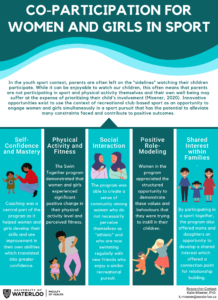 In fall 2020, a swim club piloted an 8-week, co-participation swim program at the Woolwich Memorial Centre in Elmira, Ontario. The program design stemmed from talking and consulting with stakeholders, including coaches, researchers in community sport, swim club administrators, a municipal facility manager, women, and girls (ages 8 to 13).
In fall 2020, a swim club piloted an 8-week, co-participation swim program at the Woolwich Memorial Centre in Elmira, Ontario. The program design stemmed from talking and consulting with stakeholders, including coaches, researchers in community sport, swim club administrators, a municipal facility manager, women, and girls (ages 8 to 13).
Titled Swim Together, the program brought mothers and daughters to the pool at a shared time for 45 minutes of weekly coaching (individual, small group and large-group). In all, 14 moms and 18 girls participated in sessions on swimming technique, cardiovascular fitness, and having fun in the water. Some sessions focused on particular peer groups (moms or girls) and others were mother-daughter activities.
Impact for women and girls
Other than alleviating constraints that women and girls face, Swim Together aimed to contribute to positive outcomes like improving physical and mental health, increasing self-confidence and mastery, opening doors for parent-child role modeling, increasing social connectedness, and giving sport clubs a model to implement organized, intentional opportunities for family health and well-being, particularly for women and girls. The pilot program’s early impact included:
Physical activity and fitness
Swim Together showed that women and girls both experienced significant positive change in their physical activity level and perceived fitness. Participants appreciated that the program was designed to be fun and non-competitive. The organized nature held mothers accountable to attend and helped motivate them to be physically active.
“When (the kids) swim at other times, I don’t really do a whole lot of physical activity. So this was nice to be able to actually do it with them and get that physical activity instead of just hopping in the car and dropping them off and then going back half an hour later and picking them up.”
– mom participant
Self-confidence and mastery
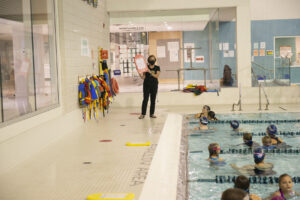 Moms like being coached! Coaching was central to helping women and girls develop their skills and see improvement in their own abilities. The program’s consistent, weekly training translated into greater confidence for participants. As their skill level developed, they were more likely to come swim lengths on their own at other times of the week.
Moms like being coached! Coaching was central to helping women and girls develop their skills and see improvement in their own abilities. The program’s consistent, weekly training translated into greater confidence for participants. As their skill level developed, they were more likely to come swim lengths on their own at other times of the week.
Social interaction
Despite COVID-19 restrictions posing some barriers, Swim Together still created a sense of community among women who didn’t necessarily see themselves as “active” or “athletic.” Now, they ‘re swimming regularly with new friends who enjoy a similar recreational pursuit.
“Especially because of COVID, I am struggling to find a social circle. Swim Together has given me a social circle on a regular basis… being able to actually be in a group in a safe space again, it’s something that I’ve definitely been missing.”
– mom participant
Positive role modeling and shared interest within families
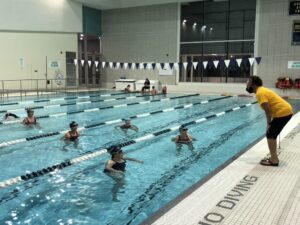 Positive role modeling was particularly important for women who felt like they weren’t necessarily modeling the values that they were trying to instill in their children. For example, values like being lifelong physically active individuals and trying new forms of physical activity. Women appreciated the structured opportunity to demonstrate these values and behaviours to their children while cultivating a shared interest.
Positive role modeling was particularly important for women who felt like they weren’t necessarily modeling the values that they were trying to instill in their children. For example, values like being lifelong physically active individuals and trying new forms of physical activity. Women appreciated the structured opportunity to demonstrate these values and behaviours to their children while cultivating a shared interest.
“I value health. And yet, I’m not living a life where it looks like I value my health. And so for me, I think the benefit is twofold…. as a mom, it’s really easy to tell your kids what you expect. But to show them what you expect is harder… I think the benefit of Swim Together is feeling good about what I’m modeling for my kids.”
– mom participant
3 strategies for sport clubs to build a co-participation program
1. Use your club’s capacity strengths to experiment with co-participation
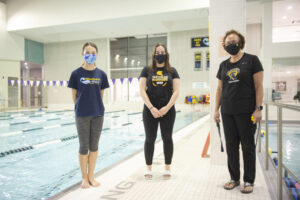 The swim club had strong coaches with shared values (that is, promoting positive outcomes for women and girls, and supporting positive family dynamics). Coaches and swim club administrators worked together to embrace new ways to use the pool facility for a program that wasn’t exclusive to youth. By successfully applying for grants to cover part of the participant fees, they were able to offer a low-cost program. If future grants are unavailable, it will be vital to communicate during the registration process that coaching has value, even though it adds to registration costs.
The swim club had strong coaches with shared values (that is, promoting positive outcomes for women and girls, and supporting positive family dynamics). Coaches and swim club administrators worked together to embrace new ways to use the pool facility for a program that wasn’t exclusive to youth. By successfully applying for grants to cover part of the participant fees, they were able to offer a low-cost program. If future grants are unavailable, it will be vital to communicate during the registration process that coaching has value, even though it adds to registration costs.
2. Embrace evaluation through research partnerships
To facilitate co-participation programming, all stakeholders must have a voice in the program’s planning, implementation and evaluation. We used a community-based partnership model that involved sport practitioners, university-based researchers, and participants. By conducting focus groups and interviews throughout the program, we learned about people’s experiences and adapted the program on an ongoing basis. Particularly for new sport programs, conducting evaluative research alongside the program provides stakeholders with new insight into specific mechanisms that can help enhance participation.
3. Use co-participation to develop pathways for lifelong participation
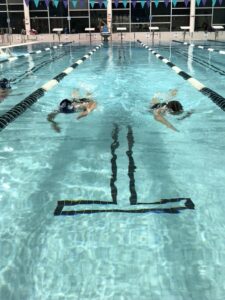 Swim Together linked many aspects that lay the foundation for lifelong physical activity and sport participation. Because their mom was present, younger girls found this program made them more comfortable participating. Some girls even expressed interest in joining the regular swim team. Whereas others, who were former members of a swim team, preferred the non-competitive physical activity in the Swim Together program. Some moms said they wouldn’t have been comfortable going solo to swim lanes, but with their daughter involved, they felt more willing to participate. While women and girls face barriers to being active at different points in life, this program offers participants an activity to help mitigate those barriers.
Swim Together linked many aspects that lay the foundation for lifelong physical activity and sport participation. Because their mom was present, younger girls found this program made them more comfortable participating. Some girls even expressed interest in joining the regular swim team. Whereas others, who were former members of a swim team, preferred the non-competitive physical activity in the Swim Together program. Some moms said they wouldn’t have been comfortable going solo to swim lanes, but with their daughter involved, they felt more willing to participate. While women and girls face barriers to being active at different points in life, this program offers participants an activity to help mitigate those barriers.
“[Swim Together] brought in more interest in swimming – both competitive swimming and swimming as a health activity. I also love that the program is bringing more girls into our centre. It’s getting parents involved and promoting mother-daughter bonding. I think it’s bringing a whole social aspect as well, so that the moms are working together and getting to know people, especially during this time with COVID.”
– Municipal Director of Recreation
Moving forward
Our program shows that having a child participate in sport doesn’t necessarily mean parents miss out on participating in sports themselves. However, sport leaders must think differently about how to organize sport and intentionally create opportunities for family health and well-being.
Swim Together offers a new co-participation model to engage women and girls simultaneously in a sport pursuit. This model has potential to help sport clubs re-imagine programs that promote the health and well-being of women and girls by allowing them to participate together in organized sport.
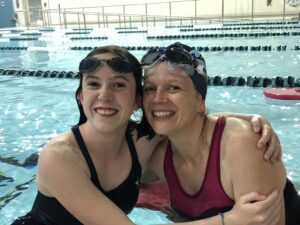 As SIRC’s recent #MomsGotGame campaign noted, our sport system needs to provide new resources and supports to overcome the unique challenges and circumstances for moms’ sport participation (Allan, 2020), particularly due to the positive influence active mothers have on encouraging their children’s sport participation (Rodrigues et al., 2018).
As SIRC’s recent #MomsGotGame campaign noted, our sport system needs to provide new resources and supports to overcome the unique challenges and circumstances for moms’ sport participation (Allan, 2020), particularly due to the positive influence active mothers have on encouraging their children’s sport participation (Rodrigues et al., 2018).
For more information about this research, please contact Katie Misener at k.misener@uwaterloo.ca.